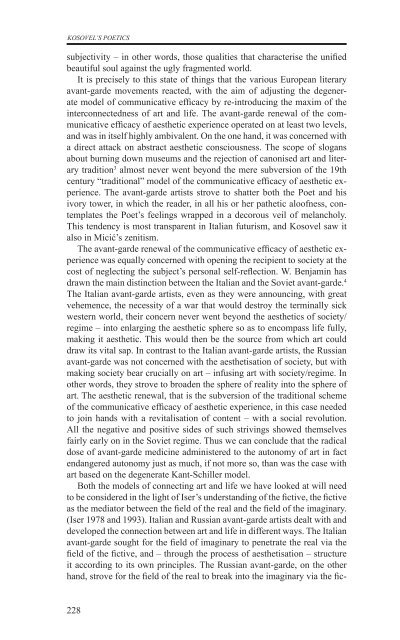razprave (pdf) - Društvo za primerjalno književnost - ZRC SAZU
razprave (pdf) - Društvo za primerjalno književnost - ZRC SAZU
razprave (pdf) - Društvo za primerjalno književnost - ZRC SAZU
- No tags were found...
Create successful ePaper yourself
Turn your PDF publications into a flip-book with our unique Google optimized e-Paper software.
KOSOVEL’s poeticssubjectivity – in other words, those qualities that characterise the unifiedbeautiful soul against the ugly fragmented world.It is precisely to this state of things that the various European literaryavant-garde movements reacted, with the aim of adjusting the degeneratemodel of communicative efficacy by re-introducing the maxim of theinterconnectedness of art and life. The avant-garde renewal of the communicativeefficacy of aesthetic experience operated on at least two levels,and was in itself highly ambivalent. On the one hand, it was concerned witha direct attack on abstract aesthetic consciousness. The scope of slogansabout burning down museums and the rejection of canonised art and literarytradition 3 almost never went beyond the mere subversion of the 19thcentury “traditional” model of the communicative efficacy of aesthetic experience.The avant-garde artists strove to shatter both the Poet and hisivory tower, in which the reader, in all his or her pathetic aloofness, contemplatesthe Poet’s feelings wrapped in a decorous veil of melancholy.This tendency is most transparent in Italian futurism, and Kosovel saw italso in Micić’s zenitism.The avant-garde renewal of the communicative efficacy of aesthetic experiencewas equally concerned with opening the recipient to society at thecost of neglecting the subject’s personal self-reflection. W. Benjamin hasdrawn the main distinction between the Italian and the Soviet avant-garde. 4The Italian avant-garde artists, even as they were announcing, with greatvehemence, the necessity of a war that would destroy the terminally sickwestern world, their concern never went beyond the aesthetics of society/regime – into enlarging the aesthetic sphere so as to encompass life fully,making it aesthetic. This would then be the source from which art coulddraw its vital sap. In contrast to the Italian avant-garde artists, the Russianavant-garde was not concerned with the aesthetisation of society, but withmaking society bear crucially on art – infusing art with society/regime. Inother words, they strove to broaden the sphere of reality into the sphere ofart. The aesthetic renewal, that is the subversion of the traditional schemeof the communicative efficacy of aesthetic experience, in this case neededto join hands with a revitalisation of content – with a social revolution.All the negative and positive sides of such strivings showed themselvesfairly early on in the Soviet regime. Thus we can conclude that the radicaldose of avant-garde medicine administered to the autonomy of art in factendangered autonomy just as much, if not more so, than was the case withart based on the degenerate Kant-Schiller model.Both the models of connecting art and life we have looked at will needto be considered in the light of Iser’s understanding of the fictive, the fictiveas the mediator between the field of the real and the field of the imaginary.(Iser 1978 and 1993). Italian and Russian avant-garde artists dealt with anddeveloped the connection between art and life in different ways. The Italianavant-garde sought for the field of imaginary to penetrate the real via thefield of the fictive, and – through the process of aesthetisation – structureit according to its own principles. The Russian avant-garde, on the otherhand, strove for the field of the real to break into the imaginary via the fic-228
















